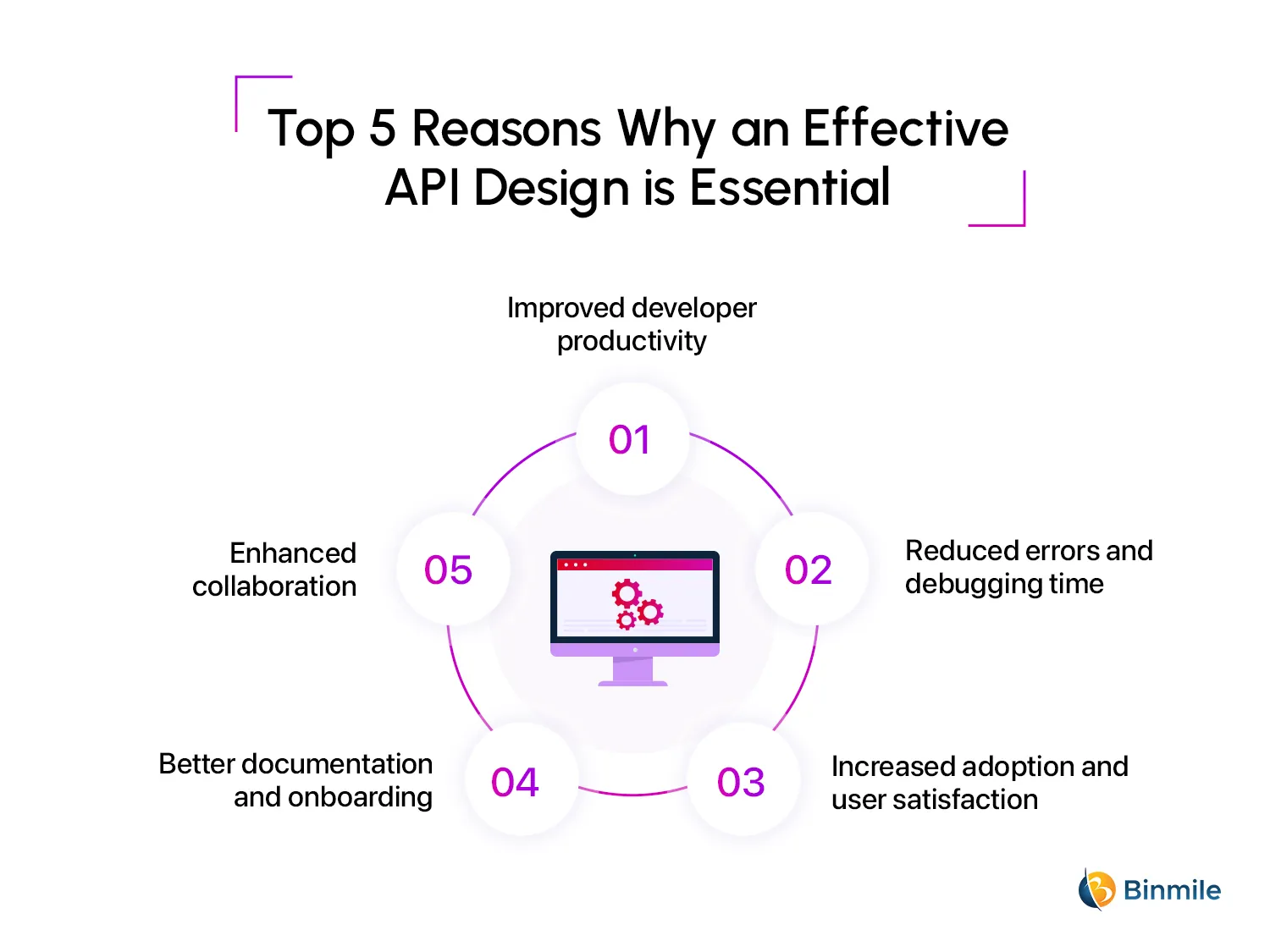API, or application programming interface, is the driving force without which much of the major technical ecosystem of web services wouldn’t exist as it does today. After all, APIs help different apps work together, whether it’s a CRM, your website, or even an embedded YouTube video, API design makes these integrations possible. While it’s difficult to build an API that meets your business requirement, it’s equally hard to design APIs that can effectively empower your API’s consumers to understand better, use, and integrate with other apps while helping you maintain it effectively. So what do you do? Are there any API design best practices to make all this happen smoothly?
Yes. However, API design isn’t just about writing the syntax and code in such a way that it’s aesthetically appealing; well, it’s part of the process, but it’s also more than that. API design also involves an outline to take the user to the API’s endpoints, methods, and resources using a standardized specification format while being user-friendly, adaptable, testable, and well-documented. Therefore, in this blog, we’ll explore 7 key best practices in API design to ensure your API is clean, well-documented, easy to use, and also widely adopted and used.
Crafting Exceptional API Design: 7 Best Practices for Developers
We have talked about what’s an API and the consequences of having a badly designed API; however, the real question is: what defines a good API? So let’s look into it before we discuss some of the key best practices for API design:
5 Key Points for Good API Design:
- Having clear and understandable naming conventions is a must.
- Intuitive structure that organizes endpoints logically for easy understanding.
- Error handling feature to provide informative error messages and aid troubleshooting.
- Implement versioning to manage changes without breaking existing integrations.
- Protect the API with appropriate authentication and authorization mechanisms.
7 Steps to Implementing API Design Best Practices: A Step-by-Step Guide
Without a doubt, a well-designed API is the backbone of any successful software application. It provides a clear interface for developers to interact with your system, making it easy to build integrations and extensions. Here are some best practices in API design:

1. Clear and Consistent Naming
Adopting a systematic approach to naming conventions enhances readability and facilitates troubleshooting. Thus, use descriptive names to accurately reflect the purpose of the API’s endpoint, resource, or parameter. Adhering to consistent naming conventions such as camelCase, and snake_case throughout your API, helps you avoid ambiguous terms to prevent misunderstandings.
2. Implement API Versioning
To ensure a smooth experience for existing users while making changes to the API, apply versioning to successfully preserve consumer trust while keeping the API secure, bug-free, and highly performant. You can do so by clearly documenting the changes between versions to help developers update their applications. Also, consider supporting multiple versions of your API for a smooth transition.
3. Comprehensive Error Handling
It’s essential that errors such as invalid requests, authentication failures, and server errors are correctly handled and conveyed to end-users. Moreover, clear and meaningful error messages enable developers to identify issues quickly. Consider using standard error formats like JSON API or OpenAPI to ensure consistency, as poor error handling could lead to downtime, bad user experiences, and loss of money and time.
4. Robust Security Measures
A comprehensive evaluation of API endpoints helps you identify and prevent vulnerabilities and their associated potential organizational risks. Therefore, utilize appropriate authentication mechanisms (e.g., OAuth, API keys) and security measures to protect your API. Additionally, regularly update and patch your API and underlying infrastructure with the latest security patches and protect the sensitive data it stores or transfers.
5. Clear & Concise Documentation
Even the most well-designed API is of little value if developers can’t figure out how to use it. Ensure your API is well-documented with clear examples, use cases, and descriptions of each endpoint, request, and response. Trying to use tools like Swagger or Postman to create interactive API documentation, making it easier for developers to test and understand.
6. Continuous Performance Optimization
Optimize your API for performance by reducing latency and response times. Implement caching to store frequently accessed data and improve response times. Regularly monitor your API’s performance to identify bottlenecks and optimize accordingly.
7. Limit Payload Size and Use Pagination
Handling large data sets can lead to performance issues, both for the client and server. So to ensure that your developers can handle large datasets effectively and deliver data in a manageable and efficient manner, try limiting payload size and implementing pagination for data-heavy endpoints, which can improve API responsiveness.
Supercharge your applications and dive into best practices for API design to unlock new possibilities.

Key Role of Good API Design in Driving Streamlining Development Processes
Why is a good API design important? It’s a question you must be wondering, but it’s a crucial deciding factor and can make or break the success of your project. It simplifies integration, reduces development time, and improves system reliability, ultimately leading to better user experiences and increased adoption. It does more, so let’s understand the benefits:

- Improved developer productivity: An API with clear, intuitive endpoints and consistent naming conventions allows developers to work more efficiently. They can quickly understand how to use the API without constantly referring to documentation.
- Reduced errors and debugging time: When an API is logically structured and follows best practices, it’s less likely for developers to make mistakes when integrating it. This leads to fewer bugs and less time spent on troubleshooting.
- Increased adoption and user satisfaction: Well-designed is easy to understand and quick to integrate and be adopted by other developers. This can lead to a larger ecosystem around your product and higher overall satisfaction among your API consumers.
- Better documentation and onboarding: More comprehensive documentation makes it easier for new developers to understand and start using the API quickly. Thus, good design often goes hand in hand with good documentation practices, such as providing clear examples, use cases, and interactive API explorers.
- Enhanced collaboration: So, it fosters better teamwork not just between frontend and backend developers but also third-party integrators, since all are in sync to know what’s happening and when and let different teams work in parallel.
Your unique challenges deserve unique solutions, and partnering with us leads to exceptional custom software development.

Summing It Up
There’s no doubt APIs and the data they expose are enabling the seamless digital experiences we enjoy every day, from mobile apps to cloud services. However, this is only possible if you have effectively designed APIs. A poorly designed API company once in production can have longer-lasting implications than just increased cost or performance issues. Although there are no set guidelines or standards to define how you have to build or design your APIs, there are certain API design best practices that can help you develop application programming interfaces in the most commonly accepted ways.
Therefore, an efficient API design is crucial for ensuring seamless integration, scalability, and a positive end-user experience. Any challenges can be successfully navigated with careful planning, knowledge of security risks, and a forward-thinking approach to adopting best practices in API design. Or you can also seek a software development company. With its extensive experience in creating custom application programming interfaces, its API developers can help you with AI-powered solutions for secured and seamless integrations.
Common Queries Answered
- Consistency: Ensure uniformity in naming conventions, response formats, and request structures.
- Simplicity: Keep APIs intuitive and easy to use, minimizing unnecessary complexity.
- Security: Implement authentication, authorization, and encryption to protect data and ensure secure access.
- Versioning: Use clear versioning methods (e.g., v1, v2) to ensure backward compatibility.
- Error Handling: Provide meaningful error messages and status codes to help users troubleshoot issues.
- Documentation: Offer clear, concise, and up-to-date API documentation for developers.
- Scalability: Design APIs that can handle growth in usage and data without compromising performance.
- Performance: Optimize API responses and ensure fast processing for a better user experience.
- Statelessness: Keep APIs stateless, meaning each request is independent and doesn’t rely on previous requests.
- Extensibility: Design with future needs in mind, allowing easy addition of new features.
- Postman: A popular tool for testing, documenting, and interacting with APIs, Postman simplifies API development and debugging.
- Swagger/OpenAPI: A widely used specification and framework for designing, building, and documenting REST APIs. Swagger UI provides interactive documentation.
- RAML (RESTful API Modeling Language): A tool for designing APIs that is human-readable and provides good documentation capabilities.
- Apiary: A platform for designing, building, and testing APIs with integrated API documentation and collaboration tools.
- Insomnia: A robust REST client for testing and debugging APIs, offering support for GraphQL, SOAP, and REST APIs.









